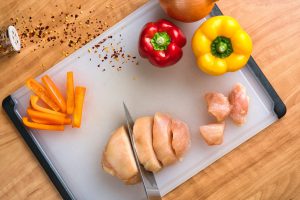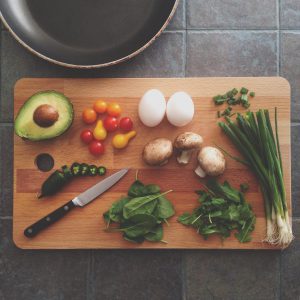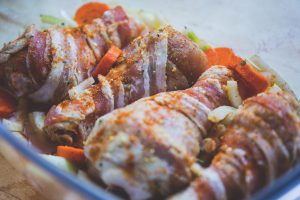In some ways, this is the most wonderful time of year for parents: the kiddos are getting set to head back to school! But on the other hand, it’s the end of the easy living of summer, and time to get back to business – and that goes for all of you out there without kids, too. We’re all about to get busier, more indoorsy, and more serious! And that means also getting back to the business of answering the age-old question that echoes in our minds every day: what’s for dinner?
The days of vacation take-out, salads made from picnic leftovers, and hasty grilled cheeses made after a day at the pool/beach are quickly ending, and you might be going into panic mode. But never fear, we’re here to help! Below we’ve got the definitive beginner’s guide to meal prepping – and if the words “meal prepping” already have you in a sweat, relax. It’s easier than you think to get started, no matter how disorganized you feel, and before you know it you’ll be a master at meal prep, and pumping out nutritious meals that will keep everyone fed, healthy, and happy all year long.
What Meal Prep Is – And Isn’t
You might think of meal prepping as being synonymous with being some perfect Pinterest or Instagram god/ess, but there are no expectations of perfection here. Let’s set aside the filtered and curated images on social media and talk about what we mean by meal prep. And that’s simply this: dedicating a bit of your time – at least weekly – to batch-cook ingredients and/or prepare meals for the week ahead to make feeding yourself and your family easier on a day-to-day basis. It’s different from meal planning in that it doesn’t simply answer the question “What’s for dinner?” for the week like meal planning does, it actually involves getting food prepared that can be easily brought out for dinner each night.
Why meal prep? It’s convenient, efficient, reduces waste, and reduces the temptation to eat outside your plan (whether the plan be a diet or a budget). And remember, meal prepping should feel like it’s making your life easier and less stressful (so forget the ‘Gram!), so you should do as much or as little as works for you. For example, meal prepping for some people might be pre-chopping all the veggies you’ll need for salads, soups, etc for the week, or stirring up a sauce that you can use in the week and then freeze for another time. For others, it might mean cooking full recipes and then dividing them up into portions to be used throughout the month.
What meal prepping isn’t is a one-size-fits-all kind of deal. It will look different for you than it does for other households, and it will even look different for you week-by-week, as your schedule and needs change. As we pointed out above, it doesn’t have to mean taking a whole day out of your weekend to craft full meals for the week ahead – unless you want it to!
With that being said, let’s take a look at the first step in learning how to meal prep: determining the best meal prep method for you.
Step 1: Determine the Best Meal Prep Method for You
Think about your mealtime pain points. Remember, meal prep is all about making your life easier (hopefully with the added bonus of helping you stick to your goals for your health and your budget)! So what are your needs? Do you want to eat healthier breakfasts, spend less on lunch, or have dinner on the table in 20 minutes after a busy day? And how much time do you realistically have/want to spend on meal prep?
Once you think about all this, you can decide to focus your meal prepping efforts on one (or more) of the methods below:
- Make-ahead meals: With this method of meal prep, you’ll cook full meals in advance, refrigerate them, then reheat them at mealtimes. This method is particularly handy for weeknight dinners. For this type of meal prepping, think of meals like casseroles, soups, stews, sauces, or anything that saves and reheats well.
- Batch cooking/freezing: Batch cooking is preparing large/multiple batches of a recipe, then portioning out what you’ve made for meals in the weeks to come. For example, you could double a chili recipe and steam extra rice, then portion everything out for lunches or dinners for the next few months.
- Individually portioned meals: Need quick, healthy lunches or breakfasts? Try this method of preparing fresh meals and portioning them into individual grab-and-go portions to be refrigerated and eaten over the next few days. Think things like overnight oats portioned into single-serving containers, mason jar salads, or cut-up veggies, nuts, and cheeses bento boxes.
- Ready-to-cook ingredients: As we stressed above, you don’t have to cook full meals when meal prepping. You can also prep the ingredients required for specific meals ahead of time as a way to cut down on cooking time in the kitchen. Even having the veggies chopped ahead of time can make a busy weeknight meal go much faster!
Again, it all depends on what works for you that week. Now let’s move on to the next step: making your meal prepping plan!
Step 2: Make a Plan
It’s time to do some planning. For this step, you’ll want to do two main things:
- Write your menu – Whatever method you’ve decided on, you’ll need to plan what you’re actually going to make. Start by relying on some tried and true recipes, and add in a few new ones – but keep it simple to save time. Our tip for keeping things as healthy, budget-friendly, and tasty as possible: plan around seasonal produce.
Remember also to pick meals that require a variety of cooking methods: you don’t want to plan 5 meals that all require the oven, for example, if you’re planning on prepping them all at once – it just won’t work. For example, you might want to stick to one oven dish like a casserole, and two stovetop dishes like a soup and a stir-fry at one time, then add in some uncooked elements. Or, make a giant batch of brown rice and some chicken breast on the stovetop, and roasted veggies in the oven, all of which can be easily assembled into everything from rice bowls to fried rice to salads.
- Schedule your prep – Meal prepping will ultimately save you a whole lot of time, but you have to remember that it also takes time! Make sure you have some time to set aside that week – maybe on a Sunday afternoon – and figure out how much you’ll have time for. Be realistic here! You might not have time that week to prep two meals a day for the whole week, but our motto is always: it’s not all or nothing, it’s all or something!
So you’re ready to get started, right? Now you need the star of the show: your ingredients.
Step 3: Take Stock and Get Shopping!
You’ve got an idea now of how you want to do your meal prepping, as well as what you want to prep…now it’s time to get the goods! Hold on, though: before you go food shopping, do the following:

- Take inventory – Having a lot of pantry staples on hand will make meal prepping easier, but before you head to the store and start stocking up on brown rice, herbs, canned beans, canned tomatoes, broth, olive oil, onions, etc take a deep dive into your cupboards and see what you actually have on hand already. Also check for the cold staples that you’ll need, like eggs, pre-cooked chicken or veggie sausage, frozen veggies, etc. And don’t forget that you’ll need lots of good containers for storage, so make sure you’ve got those, too!
- Make a detailed, well-planned list – Don’t just list things willy nilly when making your shopping list! Cut a ton of time off of your shopping trip by organizing your list by department. Try to limit grocery shopping to once a week to save time and to cut down on unnecessary buying.
Step 4: Ready, Set, Prep!
You’re ready to prep – and will soon be enjoying the fruits (and veggies) of your labor! You’ve already set aside the time to prep your meals, and now that it’s time to get started, try to further break down your prepping schedule to make the most of your time. For example, to best organize your prep and cook times, you might want to:
- Start with the recipe requiring the longest cooking time
- Once that meal is underway, focus on the rest
- Save the cold meals for last since they can easily be made while the other meals are cooking.
Here’s a hot tip: double-check the ingredients for all recipes before starting. This way, if two recipes require diced onions or cut-up peppers, you’ll be able to chop the total quantity at once. In addition, remember that small appliances like rice cookers or slow cookers are your friend when looking to save time!
Finally, keep the following food freshness/safety considerations in mind when prepping and consuming your food:
- Cook fresh meat, poultry, and fish within two days of purchase, and red meat within 3–5 days.
- Always refrigerate fresh foods and meals within two hours of purchase or cooking. For quick cooling, spread out cooked foods in shallow containers and immediately place them in your refrigerator.
- If stored in airtight containers, cut vegetables like onions and peppers will keep for 2-3 days in the refrigerator.
- Heartier vegetables, like chopped carrots and winter squash, will keep for at least 4 days.
- Lettuce and greens that have been washed, dried, and kept in the refrigerator can stay fresh for up to a week.
- Cooked vegetables, grains and dishes containing meat, poultry, seafood, or eggs should be consumed within 3-4 days, and be sure to reheat these to 165℉.
- If you’re not going to eat dishes within these time frames, freeze them! For example, for soups and cooked grains, cool to room temperature (within 2 hours) and store in quart-size plastic containers or zip-top freezer bags. Leave an inch at the top of containers for food to expand as it freezes. Top casseroles with wax paper and cover tightly in foil. Make sure to reheat everything to 165 degrees F. Consume within 3-6 months (remember to label everything!)
- Thaw frozen foods or meals in your refrigerator instead of on your countertop. For faster thawing, submerge foods in cold tap water, changing the water every 30 minutes.
- Reheat defrosted foods only once.
So there you have it: meals ready when you need them! Now get thinking about what you want to make, and how much time you want to save each week!
Bonus: What Makes a Great Meal Prep Recipe?
Not sure where to start, or if you’re picking the right kinds of meals to prep? Consider the following 5 characteristics of a great meal prep recipe:
- It has excellent make-ahead elements – Some recipes are great for making partially in advance; the author might even say something like, “If you’re making ahead of time, assemble then refrigerate/freeze.” In other words, some recipes have distinct moments in them when you can assemble ahead of time and leave the rest of the prep for later.

- It requires prep work – Sure, you could technically call boiling plain pasta prep work, but we’re talking things like lots of chopping (we’re looking at you soups and stir fries!)
- It will keep well in the fridge/freezer – Sushi, we’re definitely not looking at you.
- It reheats well – Again, keep walking sushi. Unlike raw fish, some dishes taste even better after a few days! Chilis, stews – anything like that.
- It’s easy to make in the right proportions – If you want to scale up and stock your freezer, look for recipes you can double or triple easily. If you want to make single lunches, look for things you can make smaller portions of.
There you have it: you’re ready to prep and to win at life! Forget those Insta-chefs, you’re saving time and getting on with your life – we knew you could do it. Don’t forget to tell us how it goes as you get started, and then share the go-to meal prep ideas that end up at the top of your recipe pile!

